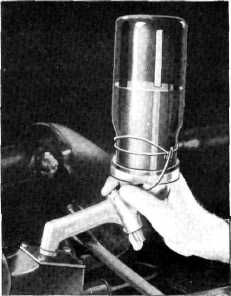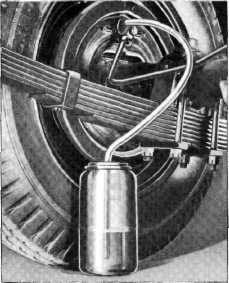1942 - 1947 CHEVROLET SHOP MANUAL
Section 5 - Brakes
|
|
|||
|
5-3 |
|||
|
|
|||
|
Unscrew
bleeder valve in wheel cylinder 1/2 to 3/4 turn.
Depress
the foot pedal slowly by hand, allowing it to return slowly. Continuing this pumping
action |
Hydraulic
Brake Fluid Super No. 9. This brake fluid is satisfactory for any atmospheric
temperature, hot or cold,
that may be encountered in car and truck operation anywhere. A good brake
fluid must have a high boiling
point to prevent evaporation and tendency to vapor lock and must also
remain fluid at low
temperatures.
Other
types of fluid are composed of ethyl alcohol and castor oil: cellosolve and
castor oil; alcohol, water, and glucose, with some chromate added to retard corrosion; mineral oil;
anti-freeze alcohols, with no castor oil added.
The first fluid in this group
makes use of ethyl alcohol which has a lower boiling point than
diace-tone alcohol, causing it to
vaporize more rapidly and
increasing the tendency to produce vapor lock in the
lines.
The
cellosolve that is used in the second type of fluid has a rather severe action on the
rubber parts in the hydraulic
system and should not be used
for this reason.
The action of the water and
glucose used in the third type hardly
requires any explanation. The |
||
 |
|||
 |
|||
|
Fig. 4—Filling Main Cylinder Reservoir
forces the
fluid through the lines and out at the bleeder drain, carrying with it any air in
the system.
When
bubbles cease to appear at the end of the bleeder drain hose in the jar and the
stream is a solid fluid mass,
tighten the bleeder valve and remove the drain
hose.
Replace and tighten the screw at
the end of the bleeder valve.
After
bleeding operation has been completed at all wheels, fill the main cylinder
reservoir approximately
full, and replace the filler plug.
NOTE—Fluid withdrawn in the
bleeding operation should not be used again.
HYDRAULIC BRAKE FLUID
There are
several general classifications of hydraulic brake fluids being sold
throughout the industry. However, for the protection of Chevrolet
owners we highly recommend the
use of G.M. |
|||
|
Fig. 5—Bleeding Brake System at Wheel
Cylinder
water, of
course, will rust and corrode the metal parts of the system: the glucose has no
lubricating qualities whatever and forms a sticky mass when exposed to air. As a slight amount of fluid
seeps |
|||
|
|
|||